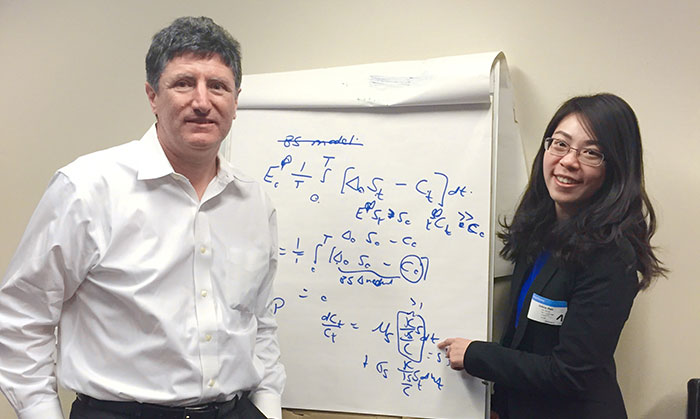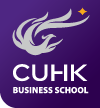CUHK Business School Research Draws Attention from the Wall Street

Dr. Peter Carr, Morgan Stanley’s Global Head of Market Modeling (left) and Xintong Zhan, a PhD student of the Department of Finance in the CUHK Business School (right)
Finance research by The Chinese University of Hong Kong (CUHK) Business School receives resounding positive feedback from investment bankers, financial professionals and fund managers in the Wall Street.
The research study entitled Option Return Predictability was written by Jie Cao, an assistant professor of the Department of Finance and Xintong Zhan, a PhD student of the same department in the CUHK Business School. The study has caught attention of famous investment banks and leading hedge funds in the Wall Street. It reveals that eight stock characteristics such as size and cash holding could predict equity option return in the United States market. A long-short strategy using delta-neutral call option writing could generate a large risk adjusted return with an annual Sharpe ratio up to seven.
The evidence of such predictability questions the price efficiency at option market. “Traditional review is that option traders are more sophisticated and better informed. However, option traders tend to focus too much on the volatility information on a limit number of stocks and their options, and neglect the relative mispricing across a large cross-section of options,” says Prof. Cao.
Based on the high relevance of this study to the quantitative trading strategies used by professional investors, Prof. Cao and Zhan have been invited to present their research at investment banks including Deutsche Bank, Morgan Stanley, and hedge funds including Cubist Systematic Strategies and Two Sigma Investments. The exposure has helped to enhance the School’s reputation on high-quality academic finance research that is highly relevant and insightful to the trading practice the real world.
Prof. Cao was invited to present this research paper at the 3rd Deutsche Bank Annual Global Quantitative Strategy Conference, which was held in New York at Deutsche Bank’s headquarter during October 14-15, 2015. Among the attendees were portfolio managers and research analysts from the largest asset managers (mutual funds, hedge funds, institutional money managers) and asset owners (pensions, endowments, sovereign wealth funds, and private banks) from around the world. Other speakers in the academia included renowned professors from the University of California, Berkeley, the Princeton University, the Duke University’s Fuqua School of Business, the Columbia University in the City of New York and more. Prof. Cao was the only speaker from a university in Asia. Prof. Cao was also invited to share the cutting edge study through a seminar at Morgan Stanley in New York City, hosted by Dr. Peter Carr, Morgan Stanley’s Global Head of Market Modeling. The other quant groups of Morgan Stanley at Budapest and Shanghai offices also participated through a video conference. As a leading expert in derivative industry, Dr. Carr held an insightful discussion with the authors.
Zhan presented this research paper at 4th OptionMetrics Research Conference, Cubist Systematic Strategies, and Two Sigma Investments. OptionMetrics is a leading source for quality historical option pricing data, tools and analytics. The event was held on 19 October at the Intrepid Sea, Air & Space Museum Complex in New York, and hosted by David Hait, the president of OptionMetics. The attendees included both academics and financial professionals from across the globe. The presentation at Cubist was hosted by Ross Goran, the head of Cubist Systemic Strategies, LLC. There were about 40 attendees including portfolio managers, quantitative researchers and strategists. Cubist Systematic Strategies is the multi-quant, systematic investing division of Point72 (formerly SAC Capital). The team uses a multi-manager platform with a multi-asset class focus to execute systematized, highly automated trading strategies across multiple time horizons. Two Sigma is a New York-based hedge fund that uses a variety of technological methods, including artificial intelligence, machine learning, and distributed computing, for its trading strategies. The 20 attendees at Two Sigma included quantitative researchers, strategists, and risk analysts. Zhan had an in-depth discussion on technical details with their equity option trading team.
The study attracts the attention of financial industry not only at New York. It has also been invited to present at the 10th Annual Conference on Advances in the Analysis of Hedge Fund Strategies on 3 December, a conference organized by the Imperial College London with attendees from the hedge funds industry at London.
For details of Prof. Cao’s and Zhan’s paper, please refer to the abstract below:
Option Return Predictability
The study examines whether the cross-section of equity option returns can be predicted with a collection of well-known stock return predictors. The answer is yes for the majority of these variables, including idiosyncratic volatility, size, past stock returns, profitability, cash holding, new issuance, and the dispersion of analyst forecast. Such predictabilities are not mechanically inherited from the stock market because stock return predictability is weak to non-existent for the underlying stocks in our sample and results from the research paper holds for delta-hedged option returns. The study documents new option trading strategies that are profitable even after transaction costs. These profits are robust across different market conditions and subsamples. They cannot be explained by standard stock market risk factors, volatility risk or tail risk. Our results have important implications for option valuation and option market efficiency.
This paper is available upon request to Prof. Cao.
Contributed by Prof. Jie Cao and PhD student Xintong Zhan

